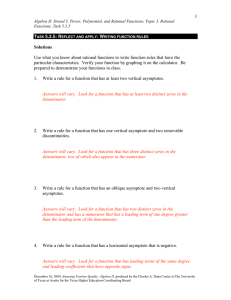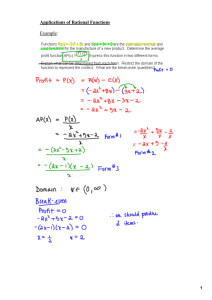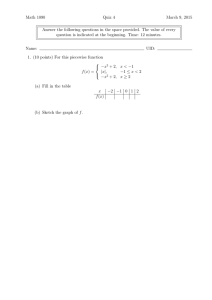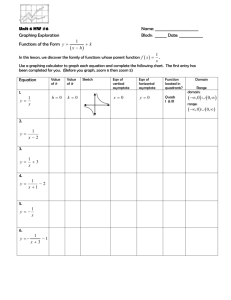Rational function ƒ of the form A function ( )
advertisement
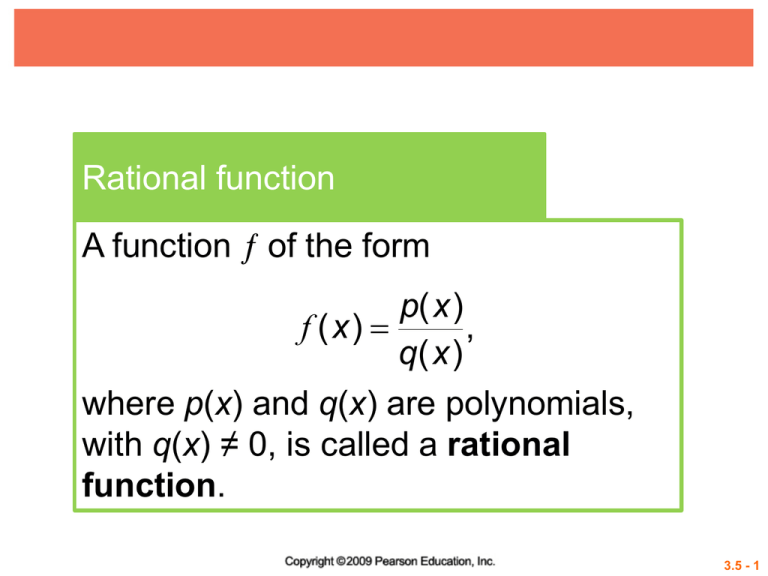
Rational function A function ƒ of the form p( x ) f (x) = , q( x ) where p(x) and q(x) are polynomials, with q(x) ≠ 0, is called a rational function. 3.5 - 1 Rational Function Some examples of rational functions are f (x) 1 x +1 3x 2 − 3x − 6 = , f (x) , and = f (x) 2 x 2x + 5 x − 3 x 2 + 8 x + 16 Since any values of x such that q(x) = 0 are excluded from the domain of a rational function, this type of function often has a discontinuous graph, that is, a graph that has one or more breaks in it. 3.5 - 2 The Reciprocal Function The simplest rational function with a variable denominator is the reciprocal function, defined by 1 f (x) = . x 3.5 - 3 1 RECIPROCAL FUNCTION f ( x ) = x Domain: (–∞, 0) ∪ (0, ∞) x –2 –1 –½ y –½ –1 –2 0 ½ 1 2 undefined 2 1 ½ Range: (–∞, 0) ∪ (0, ∞) It is an odd function, and its graph is symmetric with respect to the origin. 3.5 - 4 Example 2 GRAPHING A RATIONAL FUNCTION 2 Graph f ( x ) = . Give the domain and x +1 range. Solution 2 x +1 The expression can be 1 2 written as x + 1 indicating that the graph may be obtained by 1 y = shifting the graph of x to the left 1 unit and stretching it vertically by a factor of 2. 3.5 - 5 Example 2 GRAPHING A RATIONAL FUNCTION 2 Graph f ( x ) = . Give the domain and x +1 range. Solution The horizontal shift affects the domain, which is now (–∞, –1) ∪ (–1, ∞) . The line x = –1 is the vertical asymptote, and the line y = 0 (the x-axis) remains the horizontal asymptote. The range is still (–∞, 0) ∪ (0, ∞). 3.5 - 6 Asymptotes Let p(x) and q(x) define polynomials. For the p( x ) f ( x ) = , written in rational function defined by q( x ) lowest terms, and for real numbers a and b: 1. If |ƒ(x)| → ∞ as x → a, then the line is a vertical asymptote. 2. If ƒ(x) → b as |x| → ∞, then the line y = b is a horizontal asymptote. 3.5 - 7 Determining Asymptotes To find the asymptotes of a rational function defined by a rational expression in lowest terms, use the following procedures. 1. Vertical Asymptotes Find any vertical asymptotes by setting the denominator equal to 0 and solving for x. If a is a zero of the denominator, then the line x = a is a vertical asymptote. 3.5 - 8 Determining Asymptotes 2. Other Asymptotes Determine any other asymptotes. Consider three possibilities: (a) If the numerator has lower degree than the denominator, then there is a horizontal asymptote y = 0 (the xaxis). 3.5 - 9 Determining Asymptotes 2. Other Asymptotes Determine any other asymptotes. Consider three possibilities: (b) If the numerator and denominator have the same degree, and the function is of the form an x n + + a0 f (x) = , n bn x + + b0 where an, bn ≠ 0, then the horizontal asymptote has an equation y = . bn 3.5 - 10 Determining Asymptotes 2. Other Asymptotes Determine any other asymptotes. Consider three possibilities: (c) If the numerator is of degree exactly one more than the denominator, then there will be an oblique (slanted) asymptote. To find it, divide the numerator by the denominator and disregard the remainder. Set the rest of the quotient equal to y to obtain the equation of the asymptote. 3.5 - 11 Example 4 FINDING ASYMPTOTES OF GRAPHS OF RATIONAL FUNCTIONS For each rational function ƒ, find all asymptotes. x +1 a. f ( x ) = (2 x − 1)( x + 3) Solution To find the vertical asymptotes, set the denominator equal to 0 and solve. (2 x − 1)( x + 3) = 0 = 2x − 1 0 1 x= 2 or = x +3 0 Zero-property or x = −3 Solve each equation. 3.5 - 12 Example 4 FINDING ASYMPTOTES OF GRAPHS OF RATIONAL FUNCTIONS The equations of the vertical asymptotes are x = ½ and x = –3. To find the equation of the horizontal asymptote, divide each term by the greatest power of x in the expression. First, multiply the factors in the denominator. x +1 x +1 = f (x) = 2 (2 x − 1)( x + 3) 2 x + 5 x − 3 3.5 - 13 Example 4 FINDING ASYMPTOTES OF GRAPHS OF RATIONAL FUNCTIONS For each rational function ƒ, find all asymptotes. 2x + 1 b. f ( x ) = x −3 Solution Set the denominator x – 3 = 0 equal to 0 to find that the vertical asymptote has equation x = 3. To find the horizontal asymptote, divide each term in the rational expression by x since the greatest power of x in the expression is 1. 3.5 - 14 Example 4 FINDING ASYMPTOTES OF GRAPHS OF RATIONAL FUNCTIONS For each rational function ƒ, find all asymptotes. x2 + 1 c. f ( x ) = x −2 Solution Setting the denominator x – 2 equal to 0 shows that the vertical asymptote has equation x = 2. If we divide by the greatest power of x as before ( in this case), we see that there is no horizontal asymptote because 3.5 - 15 Example 4 FINDING ASYMPTOTES OF GRAPHS OF RATIONAL FUNCTIONS We use synthetic division. 21 0 1 2 4 1 2 5 The result allows us to write the function as 5 . f (x) = x + 2 + x −2 3.5 - 16 Example 4 FINDING ASYMPTOTES OF GRAPHS OF RATIONAL FUNCTIONS 5 x −2 For very large values of |x|, is close to 0, and the graph approaches the line y = x + 2. This line is an oblique asymptote (slanted, neither vertical nor horizontal) for the graph of the function. 3.5 - 17 Steps for Graphing Functions A comprehensive graph of a rational function exhibits these features: 1. all x- and y-intercepts; 2. all asymptotes: vertical, horizontal, and/or oblique; 3. the point at which the graph intersects its nonvertical asymptote (if there is any such point); 4. the behavior of the function on each domain interval determined by the vertical asymptotes and x-intercepts. 3.5 - 18 Example 5 GRAPHING A RATIONAL FUNCTION WITH THE x-AXIS AS HORIZONTAL ASYMPTOTE x +1 . Graph f ( x ) = 2 2x + 5 x − 3 Solution Step 1 Since 2x2 + 5x – 3 = (2x – 1)(x + 3), from Example 4(a), the vertical asymptotes have equations x = ½ and x = –3. Step 2 Again, as shown in Example 4(a), the horizontal asymptote is the xaxis. 3.5 - 19 Example 5 GRAPHING A RATIONAL FUNCTION WITH THE x-AXIS AS HORIZONTAL ASYMPTOTE x +1 . Graph f ( x ) = 2 2x + 5 x − 3 Solution Step 3 The y-intercept is –⅓, since f (0 ) 0 +1 1 = − . 2 2(0) + 5(0) − 3 3 The y-intercept is the ratio of the constant terms. 3.5 - 20 Example 5 GRAPHING A RATIONAL FUNCTION WITH THE x-AXIS AS HORIZONTAL ASYMPTOTE x +1 . Graph f ( x ) = 2 2x + 5 x − 3 Solution Step 4 The x-intercept is found by solving ƒ(x) = 0. x +1 =0 2 2x + 5 x − 3 x +1= 0 x = −1 If a rational expression is equal to 0, then its numerator must equal 0. The x-intercept is –1. 3.5 - 21 Example 5 GRAPHING A RATIONAL FUNCTION WITH THE x-AXIS AS HORIZONTAL ASYMPTOTE x +1 . Graph f ( x ) = 2 2x + 5 x − 3 Solution Step 5 To determine whether the graph intersects its horizontal asymptote, solve f (0) = 0. y-value of horizontal asymptote Since the horizontal asymptote is the x-axis, the solution of this equation was found in Step 4. The graph intersects its horizontal asymptote at (– 1, 0). 3.5 - 22 Example 5 GRAPHING A RATIONAL FUNCTION WITH THE x-AXIS AS HORIZONTAL ASYMPTOTE x +1 . Graph f ( x ) = 2 2x + 5 x − 3 Solution Step 6 Plot a point in each of the intervals determined by the x-intercepts and vertical asymptotes, to get an idea of how the graph behaves in each interval. 3.5 - 23 Example 5 GRAPHING A RATIONAL FUNCTION WITH THE x-AXIS AS HORIZONTAL ASYMPTOTE x +1 . Graph f ( x ) = 2 2x + 5 x − 3 Solution Step 7 Complete the sketch. 3.5 - 24 Example 6 GRAPHING A RATIONAL FUNCTION THAT DOES NOT INTERSECT ITS HORIZONTAL ASYMPTOTE 2x + 1 . Graph f ( x ) = x −3 Solution Step 1 and 2 As determined in Example 4(b), the equation of the vertical asymptote is x = 3. The horizontal asymptote has equation y = 2. 3.5 - 25 Example 6 GRAPHING A RATIONAL FUNCTION THAT DOES NOT INTERSECT ITS HORIZONTAL ASYMPTOTE 2x + 1 . Graph f ( x ) = x −3 Solution Step 3 ƒ(0) = –⅓, so the y-intercept is –⅓. 3.5 - 26 Example 6 GRAPHING A RATIONAL FUNCTION THAT DOES NOT INTERSECT ITS HORIZONTAL ASYMPTOTE 2x + 1 . Graph f ( x ) = x −3 Solution Step 4 Solve ƒ(x) = 0 to find any x-intercepts. 2x + 1 =0 x −3 2x + 1 = 0 1 x= − 2 If a rational expression is equal to 0, then its numerator must equal 0. x-intercept 3.5 - 27 Example 6 GRAPHING A RATIONAL FUNCTION THAT DOES NOT INTERSECT ITS HORIZONTAL ASYMPTOTE 2x + 1 . Graph f ( x ) = x −3 Solution Step 5 The graph does not intersect its horizontal asymptote since ƒ(x) = 2 has no solution. 3.5 - 28 Example 6 GRAPHING A RATIONAL FUNCTION THAT DOES NOT INTERSECT ITS HORIZONTAL ASYMPTOTE 2x + 1 . Graph f ( x ) = x −3 Solution Step 6 and 7 The points (–4, 1), (1, –3/2), and (6, 13/3) are on the graph and can be used to complete the sketch. 3.5 - 29 Behavior of Graphs 3.5 - 30 Example 8 GRAPHING A RATIONAL FUNCTION WITH AN OBLIQUE ASYMPTOTE x +1 Graph f ( x ) = . x −2 Solution In Example 4, the vertical asymptote has equation x = 2, and the graph has an oblique asymptote with equation y = x + 2. Refer to the previous discussion to determine the behavior near the vertical asymptote x = 2. 2 3.5 - 31 Example 8 GRAPHING A RATIONAL FUNCTION WITH AN OBLIQUE ASYMPTOTE x +1 Graph f ( x ) = . x −2 Solution The y-intercept is – ½ , and the graph has no x-intercepts since the numerator, x2 + 1, has no real zeros. The graph does not intersect its oblique asymptote because 2 3.5 - 32 Example 8 GRAPHING A RATIONAL FUNCTION WITH AN OBLIQUE ASYMPTOTE x +1 Graph f ( x ) = . x −2 Solution 2 x +1 = x+2 x −2 2 has no solution. Using the y-intercept, 2 1 , − − asymptotes, the points 4,17 and , 2 3 and the general behavior of the graph near its asymptotes leads to this graph. 3.5 - 33 Example 8 GRAPHING A RATIONAL FUNCTION WITH AN OBLIQUE ASYMPTOTE x +1 Graph f ( x ) = . x −2 Solution 2 3.5 - 34


